She is about to add, “I have scars, inside me,” but she stops herself. What is a scar, Oh Toby? That would be the next question. Then she’d have to explain what a scar is. A scar is like writing on your body. It tells about something that once happened to you, such as a cut on your skin where blood came out.
— MaddAddam, Margaret Atwood
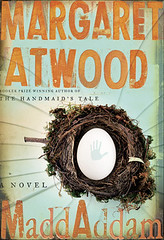
MaddAddam
Margaret Atwood
![]()
The third and final volume of Margaret Atwood’s trilogy about the cleansing and rebirth of humanity. The first book, Oryx and Crake, took us into the near future of failed governments, corporate city-states, social breakdown, and the final rape of the planet. The second, The Year of the Flood, followed a few survivors of the engineered plague that wiped out almost all human life. MaddAddam brings the two storylines back together as we witness what may be the beginning of a new era on earth, and a new kind of humanity.
Of course that’s the barest of outlines. The men and women Atwood creates are vivid; she takes you inside their lives and thoughts and if you’re like me you’ll fall in love with some of them — and even if you don’t you’ll care enough about them to keep reading.
Some say the individual books of this trilogy are not stand-alone novels. I disagree, at least when it comes to Oryx and Crake and The Year of the Flood. I do agree, however, that MaddAddam needs to be read in the context of the first two books, despite Atwood’s attempt to orient readers with a short summary at the beginning. So if you’re going to read MaddAddam, stop and read the first two books first. If you don’t, you may wonder what all the fuss is about. If you do, your experience will be a rich one.
As with Orwell’s vision of a totalitarian future in 1984, Atwood’s vision of a chaotic future on a depleted planet has stayed with me, and I’ve found myself quoting or paraphrasing parts of her story to friends in daily conversation. There are very few authors I can say that about.
Now that all three books of the trilogy are in print, I plan to read them again, this time back to back. I bet many other Atwood fans plan to do the same. The indivudual books may register as four-star reads, but the trilogy as a whole is a solid five-star work.
By the way, how’s this for a coincidence? I finished this book on Sep 30, 2013, the day the US government failed. Was that a CorpSECorp truck I just saw driving through the neighborhood?
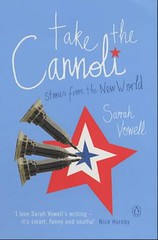
Take the Cannoli
Sarah Vowell
![]()
Take the Cannoli is a collection of Sarah Vowell’s essays and spoken stories, most of the latter originally performed on This American Life, a public radio show. Even the essays, presumably not written to be read aloud, give you the sense Sarah is speaking to you, which adds a great deal of charm to her observations and confessions. She’s an insightful observer of people, places, moods, trends, culture, and society at large. She’s also disarmingly frank about herself. I always feel, after reading Sarah Vowell, as if I’ve just had a long conversation with an unusually open and honest friend.
I enjoyed every story in this collection. I may not have learned as much about American history (Jackson’s betrayal of the Cherokee people and the Trail of Tears notably excepted) as I did reading The Wordy Shipmates or Unfamiliar Fishes or Assassination Vacation, but I learned about Sarah, and I liked what I learned.
She’s a very engaging writer. I suppose I should look up the recordings of her This American Life shows and listen to them, and I eventually will. Meanwhile, I treasure her writing and recommend her to one and all.
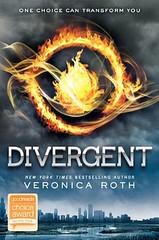
Divergent (Divergent #1)
Veronica Roth
![]()
The first of a planned series of young adult science fiction novels set in a future dystopia, it’s a bit like The Hunger Games in that the heroine is a young girl coming into adulthood and leading a revolution against the established order, testing herself physically and emotionally, beginning to discover her sexuality.
I read it all the way through without connecting with Tris or coming to care about her, and will not read the rest of the series. The problem is my inability to suspend disbelief: I couldn’t buy the novel’s premise. The future society Veronica Roth sets up didn’t seem possible to me in the way Suzanne Collins’ feudal post-catastrophe America did, the way Paolo Bacigalupi’s landscapes of ecological ruin do. I don’t believe people would ever choose to join mutually-exclusive factions, one devoted to telling the truth, another to defending the realm, another to selflessness, another to friendliness, and so on, like a society of highly specialized Quakers or Puritans. It isn’t human and doesn’t make sense, and if you can’t buy the author’s vision you can’t enjoy her novel.
Otherwise Divergent is standard semi-dark YA, moral and even religious in tone, with no smutty sex other than a kiss or two, so I don’t expect to hear about the parental challenges and bannings that have accompanied other popular YA series.
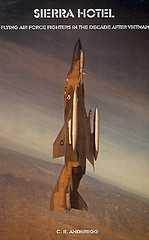
Sierra Hotel: Flying Air Force Fighters in the Decade After Vietnam
C.R. Anderegg (with Richard P. Hallion)
![]()
Interesting Air Force history by a fighter pilot who straddled two eras: flying F-4s in Vietnam, then F-15s and F-16s during the “fighter mafia” years afterward. The point of his book is to show how neglected the fighter business was during the early years of Vietnam, with inadequate training, lousy weapons, WWII tactics, and poorly-designed jets, then to contrast that time with the boom years that followed, when aggressive and smart fighter pilots were finally able to improve training, weapons, tactics, and airplanes.
As a fighter pilot who came into the business during the post-Vietnam boom years, I always felt lucky in my timing. I was aware of the problems associated with the tactics, training, and aircraft earlier generations of fighter pilots had to endure, and thankful I started flying fighters in an era when fellow fighter pilots were in charge and could make sensible decisions. Anderegg’s history expanded my knowledge and confirmed what I had always felt.
Anderegg was one or two year groups ahead of my own, and he flew with and knew several notable fighter pilots who were becoming the new generation of USAF leaders when I started flying the F-15. It’s always interesting to get a glimpse of your leaders back when they were young sierra hotel fighter jocks themselves.
I downgraded what should have been a three- or three-and-a-half-star rating to two-and-a-half because the Kindle ebook version I bought is so screwed up it verges on FUBAR. It’s as if no one bothered to look at the ebook version before making it available to readers. Pagination is chaotic. Footnotes are interspersed randomly throughout the text, frequently in the middle of unrelated paragraphs, sometimes even interrupting sentences. Chapters end and begin without page breaks.
Illustrations are even worse: the book is supposed to contain diagrams showing the various types of combat formations flown by USAF fighters, pre- and post-Vietnam, as well as depictions of tactical turns, radar search patterns, and missile envelopes. Not a single illustration made it into the Kindle version in the form it was intended … instead they have all been replaced with meaningless profile drawings of F-4s and MiG-21s. I’m an experienced fighter pilot and didn’t need the illustrations to begin with, but I can imagine the frustration a non-pilot reader might feel: how does this stupid side view of an F-4 show me how to perform a delayed 90-degree turn; how does this crude pencil drawing of a MiG-21 show me what a Vietnam-era welded wing formation looked like?
The lack of formatting and the screwed up illustrations made the ebook version an effort to read, and I do not recommend interested readers take that route … go find a printed copy, and check the illustrations first to make sure you’re not just getting a printout of the messed up ebook.
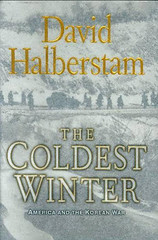
The Coldest Winter: America and the Korean War
David Halberstam
![]()
A well-researched book about leadership, military and political, during the Korean War. Halberstam doesn’t confine himself to Truman and MacArthur; he examines Chiang Kai-shek, Kim Jong Il, Stalin, and Mao as well. Nor does he confine himself to top-tier leadership: he digs down past the Joint Chiefs into Army leadership, all the way down to lieutenants and NCOs at company and platoon level. If you can keep a million historical facts straight, Halberstam’s book is a tour de force. If the level of detail overwhelms you, particularly during the descriptions of individual battles in Korea, it can be a confusing tour.
Halberstam paints an absolutely damning portrait of MacArthur and his sycophantic staff, especially his criminally-negligent chief of intelligence, Colonel Willoughby, and the racist and incompetent General Almond, the headquarters chief of staff he put in charge of combat in Korea. I knew the old buffoon had a giant ego; I had no idea how out of control it was. Halberstam’s portraits of Truman, Acheson, and Eisenhower are far more sympathetic.
I learned where a lot of the Republican animus toward Democratic administrations comes from: it comes from being out of power for two decades during the Roosevelt and Truman years, aggravated by the defeat of Chiang Kai-shek at the hands of Mao’s communist guerrillas, which the GOP internalized as weakness on the part of the Democrats, a failure which never would have happened had they been in charge. During the Korean War this animus metastasized into accusations of being soft on communism and led to the McCarthy witch hunts. So many of the pathologies we see in today’s politics had their origins in the early 1950s, directly connected to China and Korea. Much of this was a revelation to me.
Great history, important stuff. There is so much we don’t know about the Korean War. It was hated at the time, then deliberately forgotten. Halberstam did a great service writing this book.
I am now determined to learn more. Halberstam, as I said, concentrates on leadership, but he also goes into great detail on the ground war itself, before and after inchon, before and after our initial defeat at the hands of the Chinese (curiously, though, he says little about the battle at Chosin Reservoir and the evacuation of American forces afterward, the one thing Americans who know anything about the Korean War might remember). And of course I am a student of air power and the conduct of air campaigns during wars, about which Halberstam says nothing … not that I’m complaining, since that isn’t the subject of his book … but I want to know more and now that I’ve read Halberstam on Korea I will have to read other histories of the war.
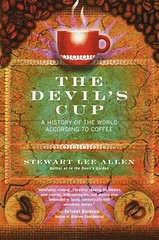
The Devil’s Cup: A History of the World According to Coffee
Stewart Lee Allen
![]()
Well, it’s mostly about coffee, but coffee as a theme to unify a travel adventure story of the penniless backpacking variety. This is not a book I would have picked out for myself, but my book club selected it as a monthly read and I’m glad they did.
Allen’s off-handed and fantastical claims as to the importance and centrality of coffee in mankind’s advancement are just that, off-handed and fantastical, but thought-provoking nonetheless (he talks, for example, about pre- and post-coffee humanity, with the former depicted as sluggish and stupid … a facile observation, to be sure, but one most of us would be willing to accept). The anti-coffee restrictions and persecutions that followed the introduction of coffee around the world echo on today with certain religious groups, something I find amusing.
Early in the narrative, Allen describes a Middle-Eastern art-fraud scam he manages to get himself involved in. He hopes to cash in during a subsequent visit to Paris. I read the Paris chapter twice and never did find out what happened. I probably missed it, but feel somewhat let down that I had to search so hard for it and then never managed to find it. My only criticism.
On-going Reading Project:
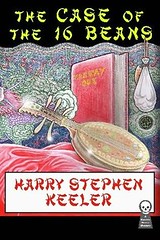
The Case of the 16 Beans
Harry Stephen Keeler
Imagine my surprise to learn that the Twitter account of @HarrySKeeler (a typical Tweet: “To make it brief, I have the guy, as I said, over a barrel, lock, stock, and barrel, and call that redundancy if you want to.”) is not a joke account but a tribute to a writer sometimes compared to movie director Ed Wood, a prolific writer who “arrived at ‘good’ by a road no one else could have possibly traveled.”
When I learned Harry Stephen Keeler was for real, I immediately downloaded The Case of the 16 Beans, a mystery he wrote in 1944.
In brief, it’s about an heir whose grandfather spitefully leaves him, not the fortune he expected, but a cloth pouch containing 16 dried beans, the result of a series of improbable misunderstandings.
It’s hard to say whether HSK was a hack, a lunatic, or a genius. His writing is certainly eccentric. It’s also horribly dated, filled with racist references and hilarious attempts at dialect … but in spite of that not off-putting as you might expect. In fact, HSK is a kick to read. In short doses, that is. Reading HSK is a bit like enjoying horrible old science fiction movies on Mystery Science Theater 3000 … full of laughs but you don’t want to wear yourself out by watching back-to-back episodes.
So for now, three chapters in, I’m putting The Case of the 16 Beans on my reading-episodically shelf. I’ll pick it up again from time to time, whenever I need a good laugh.